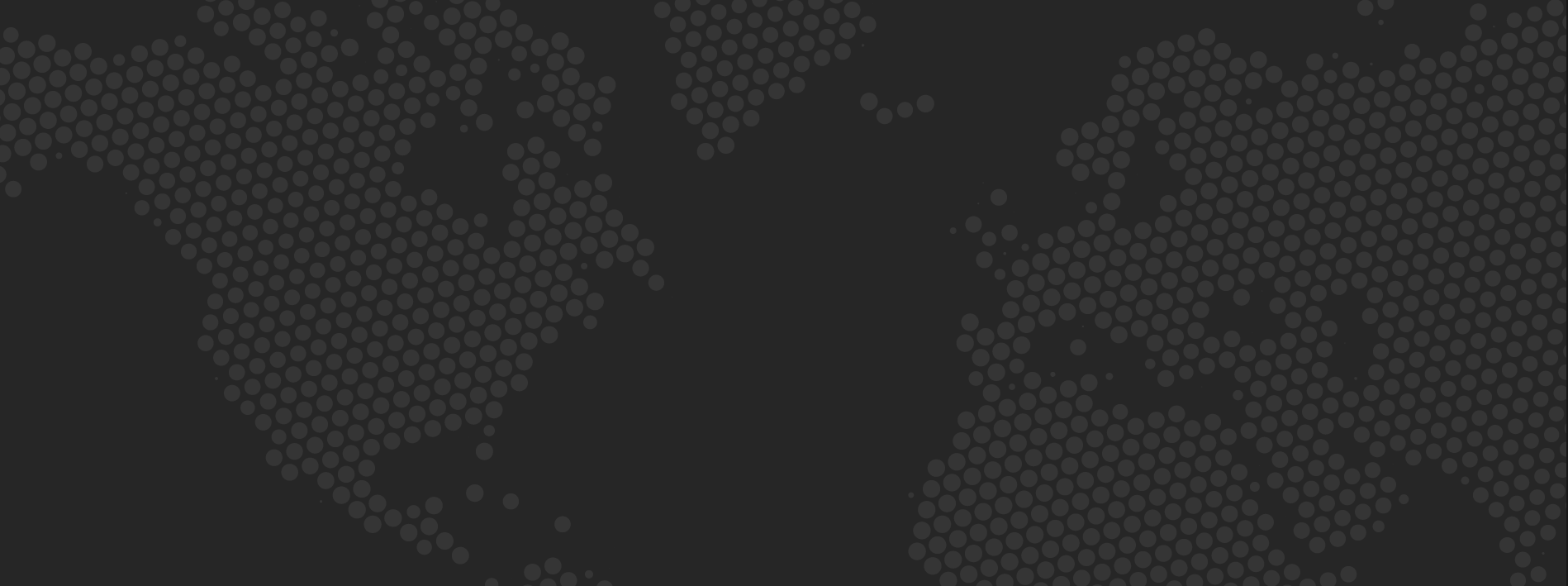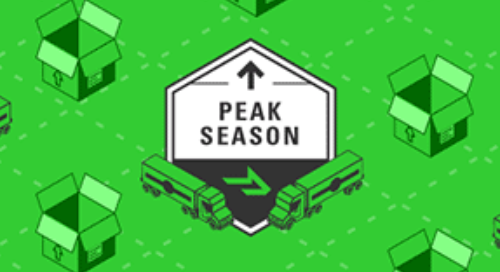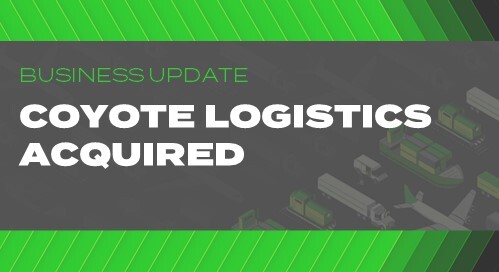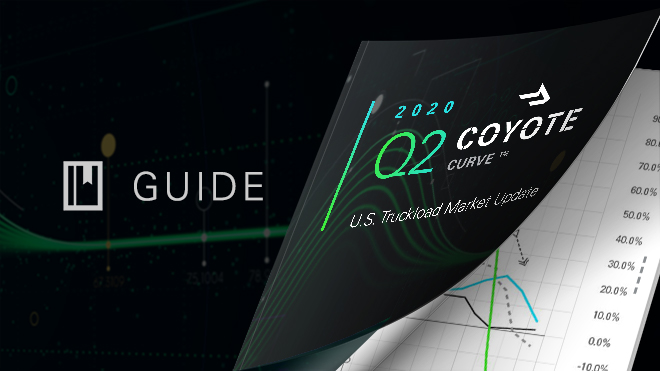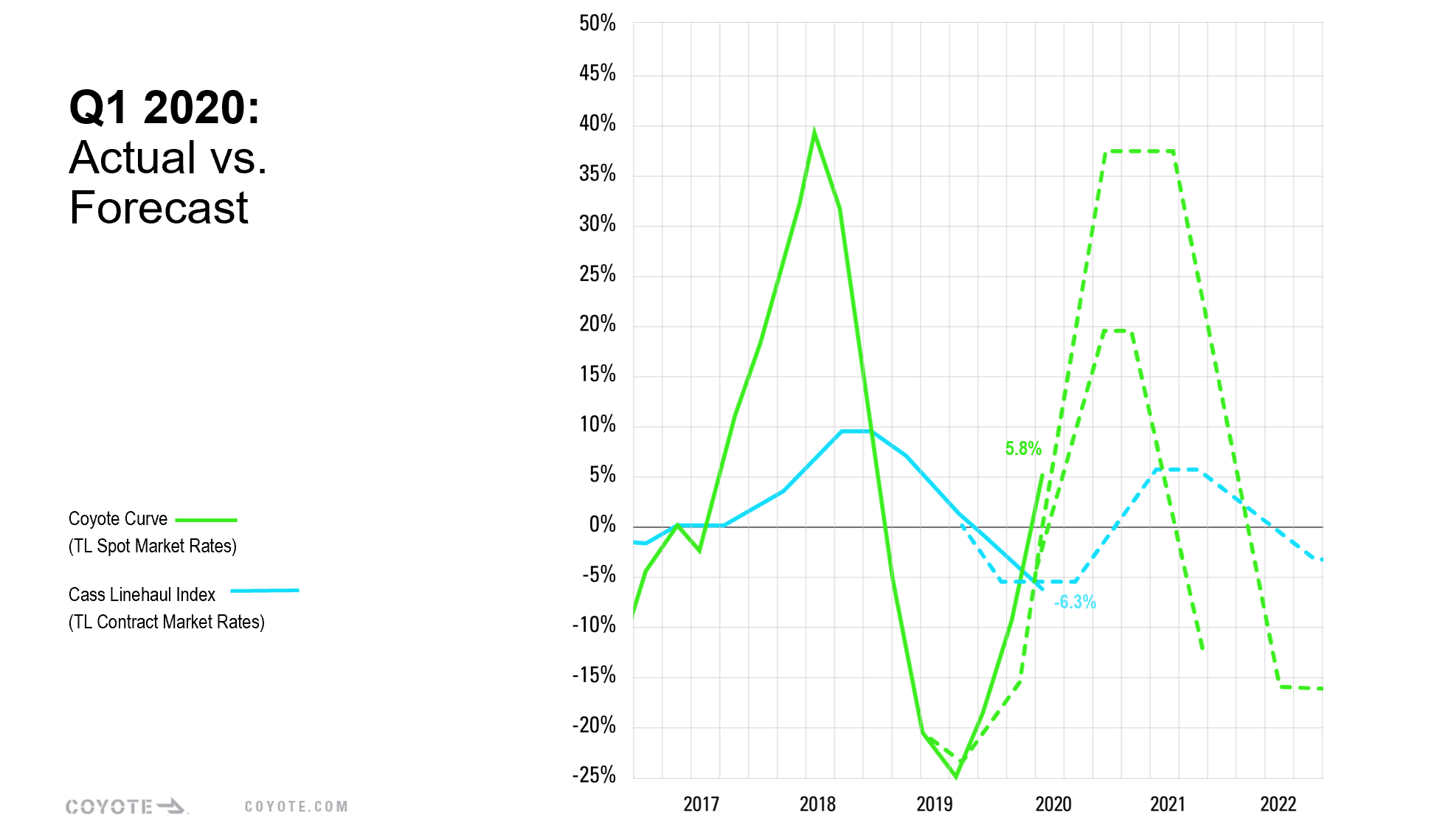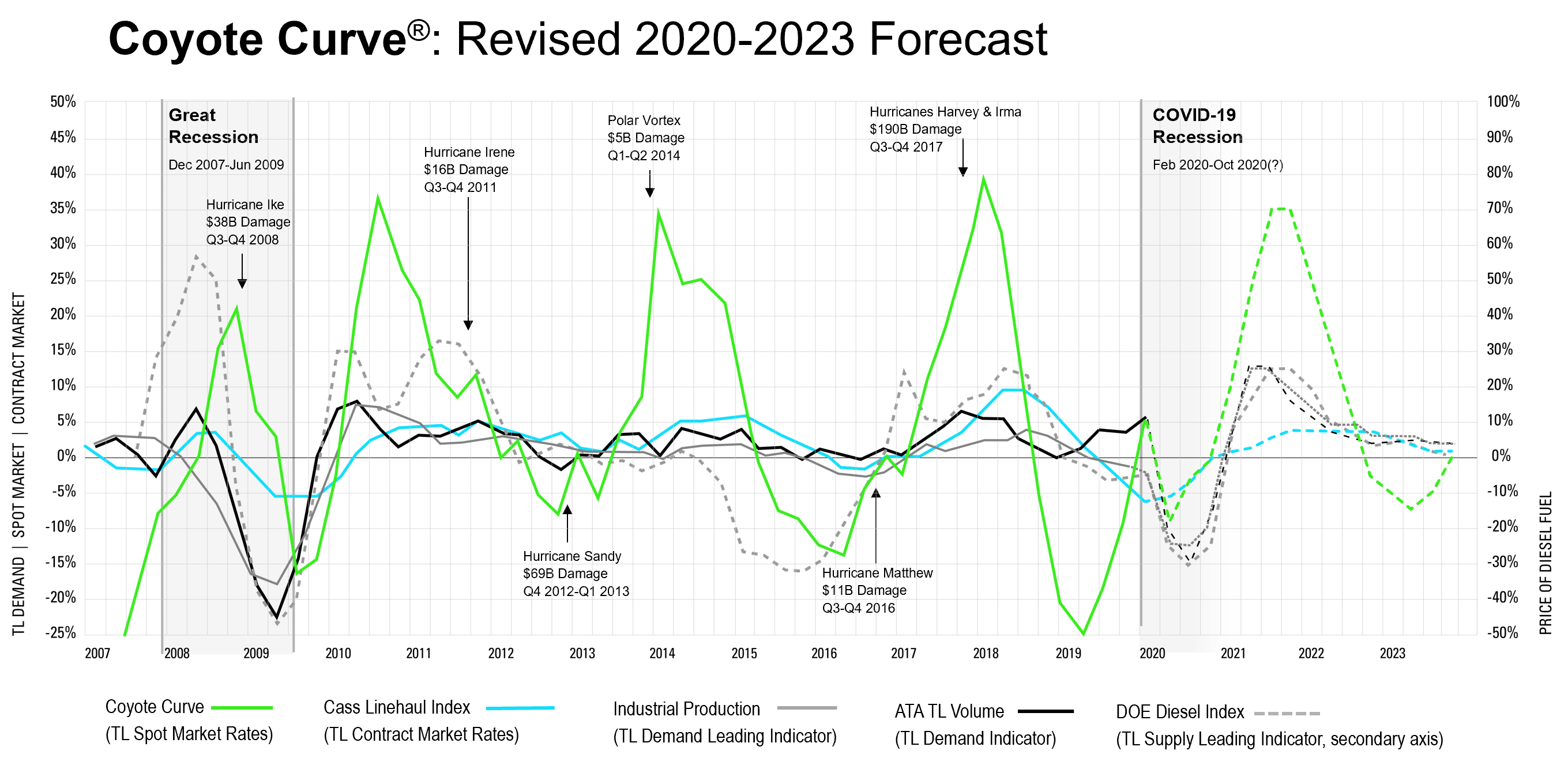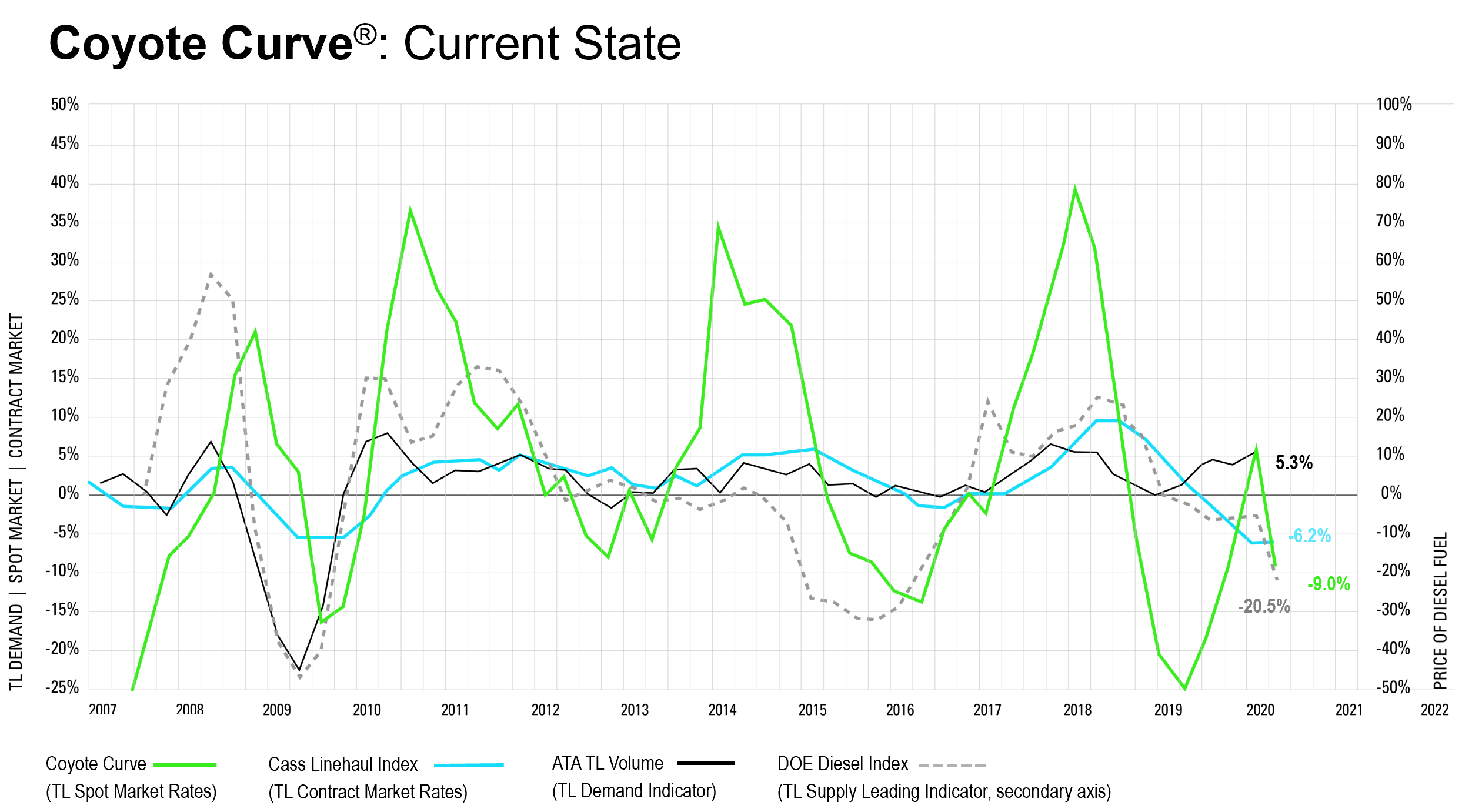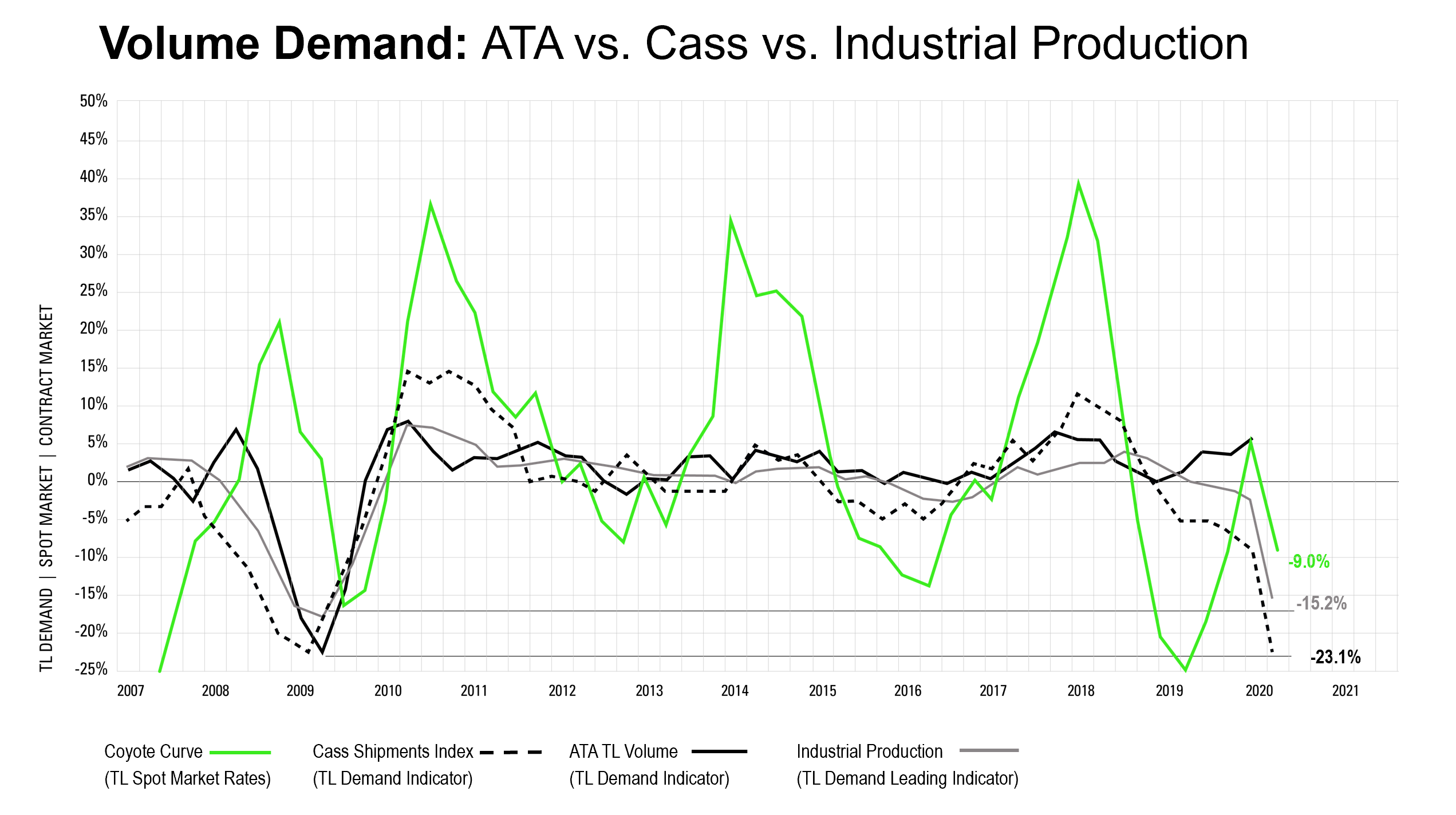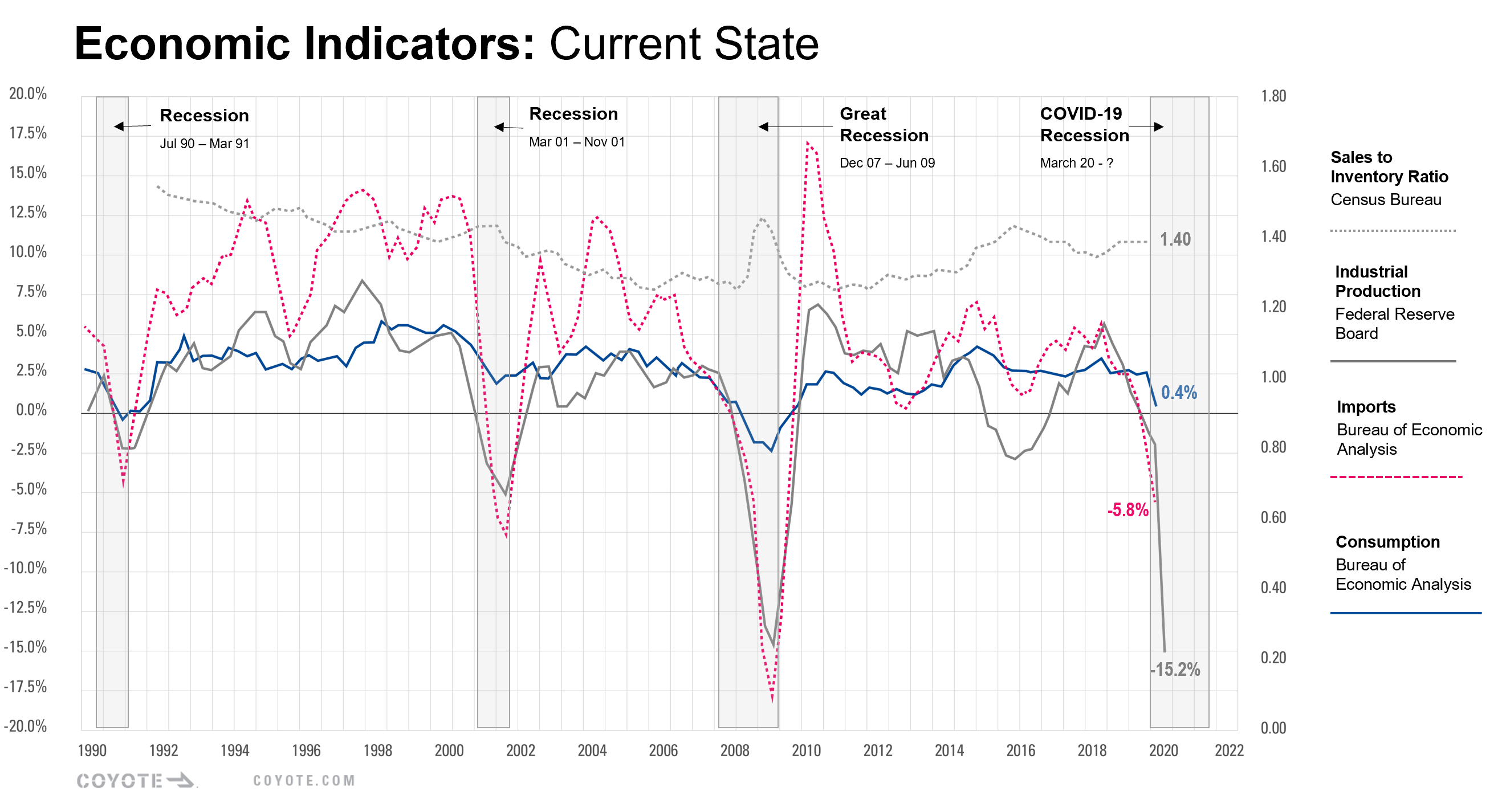Q2 2020 Coyote Curve Truckload Market Guide
Over the past quarter, shippers and carriers have experienced one of the most volatile truckload environments — if not the most — in history. Given the seismic changes happening around the world, this comes as no surprise.
Despite the fallout from the COVID-19 pandemic, with Q1 numbers in the books, we found our forecast to be in-line. However, Q2, which began once the nation was sheltering-in-place, will be a very different story.
“We’ve been doing the Coyote Curve® quarterly reports for over a year now, and I can’t remember a quarter that has experienced this much change.”
-Chris Pickett, Coyote CSO on Q2-to-date figures in the Q2 Coyote Curve webinar.
We took insights from our recent Q2 Coyote Curve® panel discussion — which you can watch on-demand — and created this market guide, where we’ll cover:
- Q1 market performance
- Updated forecast for 2020 and beyond
- Q2-to-date market performance
- Current state of the economy
- Strategies to prepare for the recovery (shippers & carriers)
Original Coyote Curve Forecast (Pre-COVID19)
Coming into Q1 2020, we anticipated the end of our fourth observed market capacity cycle and the beginning of the fifth. We expected a surge in year-over-year spot rates, and a continued drop in contract pricing.
There were enough economic indicators (e.g. declining Industrial Production) signaling the potential for an economic recession that we provided two versions of our forecast — one with a recession and one without recession.
Both versions predicted that we would have an inflationary spot truckload market in Q1; in the recession scenario, the market peak would just occur sooner, at a lower level, and begin its descent towards a deflationary market faster.
New to the Coyote Curve forecasting model? You can learn about the dynamics of the U.S. truckload market and how we build our model to get the most out of this guide and become a market pro.
Q1 2020 Coyote Curve: Actual vs. Forecast
We certainly have a recession, though the catalyst (COVID-19 pandemic) was unexpected, even as late as mid-February when we published our Q1 2020 update.
Despite the seismic shifts happening in the truckload market (and the global economy at large), Q1’s numbers ended up in-line with our forecast, as most of the severe sheltering-in-place didn’t begin until the end of the quarter.
Spot Rate Index (Green Line)
This is our proprietary Coyote Curve line that measures year-over-year change in spot market activity.
- Q4 2019: -8.1%
- Q1 2020: +5.8%
- Change from Q4 to Q1: increased 13.9%
Contract Rate Index (Blue Line)
The Cass Linehaul Index is our proxy for the year-over-year change in contract rate activity.
- Q4 2019: -3.2%
- Q1 2020: -6.3%
- Change from Q4 to Q1: decreased 3.1%
Updated Q2 2020 Truckload Market Forecast
There has been a big enough shock to the global economy that we are revisiting our previous forecast.
With an unprecedented slowdown in shipper demand paired with a collapse in diesel, we need to redraw the map.
While we closed right on forecast in Q1 2020, we think there will be a steep drop in shipper demand (volume) and fuel, driven by dramatic decline in Industrial Production (the gray line on the chart below).
This will pull down spot rates (which have likely already found their bottom) before trending back up and finishing the quarter around -5%.
Want a PowerPoint version of our Q2 2020 Coyote Curve forecast? Download on SlideShare.
Long story short, the truckload market we predicted for 2020 will be delayed a year, sliding our original forecast back to 2021.
Why the COVID-19 Recession Is Different than the Great Recession
As mentioned, our Q4 2019/Q1 2020 forecast accounted for the possibility of a recession, using 2007-2008 as a guide — why is that no longer valid?
In the Great Recession, we experienced a financial crisis driven by a collapse of the housing market, causing Industrial Production — and truckload volume — to plummet, yet we still experienced an inflationary market.
There are two main reasons that is not happening today:
- The severe and traumatic nature of the COVID-19 recession
Sheltering-in-place and full stoppage of several sectors of industrial activity made the economic decline incredibly fast and steep — the shock to the market occurred much faster than in the Great Recession. - Diesel is deflationary
In 2007-2008, runaway diesel prices effectively pushed carrier capacity out of the market, as the spike in fuel rose much faster than truckload rates. This lack of carrier capacity more than made up for the decline in volume.
Q2 2020 Coyote Curve: Mid-Quarter Performance Review
We don’t usually bring mid-quarter data into our updates, preferring to wait until all the numbers are fully baked for better comparisons and to build more confidence in the figures.
However, given the nature of the current environment, we decided to provide our Q2-to-date figures as well.
As of May 20th, 2020, we’re at:
- Coyote Curve Index (spot rate proxy): -9.0%
- Cass Linehaul Index (contract rate proxy): -6.2%
- ATA TL Volume (demand indicator): +5.3%
- DOE Diesel Index (supply indicator): -20.5%
What Has Happened in Q2 So Far
After Q1 closed out at +5.8%, we whipsawed down to -9%, and think we will close out the quarter closer to -5% to -7%, as the economy starts to slowly pick back up.
In first half of March, we had a wild spike in rates as pantry stocking drove up consumption, rocketing rates up to 16% for a two-week period. Then came the fall, and our index dropped 30% as the market found the floor around the first week of May.
Since then, spot rates have climbed 16%, ending up at -9% (as of May 20th). Contract rates are flattening after a year of decline, and have likely found their bottom as well. Diesel is fading even lower with the recent collapse in oil prices.
Our proxy for volume; however, is actually at +5.3% — how is that possible? Let’s take a closer look.
Q2 2020 Truckload Volume Indicators
We use the American Trucking Association’s (ATA) volume index as our proxy for shipment volume in the truckload market. Despite a historically bad economy, as of late May, it was showing at +5.3%.
How can that index be up in this environment? The index is derived from ATA-member carriers filling out surveys every month — it’s rooted in their perception.
Let’s compare to the Cass shipment index, another volume indicator, and Industrial Production.
Typically, both the Cass and the ATA volume indices closely track Industrial Production (IP). The exception: when we’re about to dip into a recession.
Looking back to 2008, the ATA index took longer to tip over, continuing to climb even when IP and the Cass index were tanking, before making its own descent a couple quarters later.
Why is that the case? The ATA index represents the carrier community, versus the Cass index, which represents shippers.
With the rate of carrier exits, it might feel like there is a decent amount of volume in the market given the supply/demand balance, but that sentiment won’t last forever.
The truth is, there is less truckload volume in the freight economy, and eventually (almost certainly by our next update), the ATA index will follow Industrial Production and drop.
State of the Economy: 4 Economic Indicators and 4 Recessions
We have talked a lot about Industrial Production (IP), which we use as a primary leading indicator. We also use Imports, Consumption and the Sales-to-Inventory Ratio to inform our forecasts.
Let’s take a quick look at their performance through the four economic recessions since 1990.
On the downside: IP came down to meet the trough of the last recession.
On the upside: we believe that we have likely experienced the worst, and should start to see it pull upwards.
Furthermore, we believe that — barring another significant outbreak of infections — we should see a fairly steep recovery in the back half of 2020 and into 2021.
Consumption was stable leading into this recession, as opposed to the previous three, where Consumption slowly tilted downward leading into a recession.
The drop to 0.4% is the steepest we’ve seen in the last 30 years (and the next update will be worse as the full effect of sheltering-in-place shows up in the data), but there seems to be some symmetry between IP and Consumption: the steeper the decline, the more rapid the recovery.
Market Forecast Summary
Though we expect a steep drop once all Q2 numbers are in the books, we have likely already hit the bottom in Q2.
We expect contract and spot rates to more or less converge from here, and an inflationary 2021 spot truckload environment (barring a major economic setback).
For the rest of 2020, if you work in procurement, it will probably be a forgiving rate environment, but we do expect a lot of volatility.
Origin and destination pairs will change, volumes will be unpredictable, and bid awards will shift as vendors, customers, carriers and trading partners experience supply chain issues or outright default.
That said, the negative rate impact won’t be nearly as severe as a normal inflationary environment.
Could the Outlook Shift Again? 3 Core Assumptions
If the past few months have been any indicator, things can change quickly. Though we feel confident in our forecast, there are three core assumptions that if altered, may require another update to the model.
- The country, and economy, will continue to open up, and we avoid another lockdown to the extent of March through May.
- Diesel will continue to fade slightly lower for another quarter or two. If it increases significantly, it could move up the inflationary market. If it plummets significantly, it could prolong the spot rate recovery.
- We avoid a series of major storms. If we do have a few bad events, particularly in the gulf coast, it could drive a greater ripple throughout the freight market, giving a upward spike to spot rates, before the market resets and continues its trajectory (look to Hurricane Sandy as an example). Early readings are showing the potential for an active hurricane season.
The Road to Recovery
We are in the depths of one of the worst economic environments in modern history, but we will recover, and we don’t believe it will be in the distant future.
Whether you are a shipper or a carrier, whether you are currently active or anxiously waiting to get your business up and running, there are some actions you can take to get ready for the bounce back.
For Shippers
- Develop a thorough return-to-work strategy.
Whether you are totally dormant right now, or just have some portion of your workforce operating remotely, you need to document your process and communicate it with your employees. - Have a firm understanding of regulations.
Though there has been a lack of clarity from a federal level, go local. Ask your local police departments and Chamber of Commerce for advice on what you can and can’t do, as well as best practices. - Contact your strategic providers.
Whether it’s a supplier or a carrier, you need to know what will be available to you in the coming months, both in terms of inventory and how you’re going to move it. - Add flexibility.
Find out ways simplify production. Pare back product lines and minimize SKU counts. Make the shift with a mind towards in-home consumption. Work with providers that are going to be able to help you pivot quickly. - Stick to Your KPIs
Don’t let the current chaos distract you from core performance indicators for your carrier base. Make sure you have a way to track performance and hold your carriers accountable.
For Carriers
- Have a solid understanding of what money is owed to you.
Now more than ever, every dollar counts. Revisit outstanding accessorials and follow up with providers. Make sure the well-deserved revenue you earned is actually getting into your account. - Revisit payment terms.
Even if you’re using a factoring company, look at how you are getting paid from each provider. Can you find ways to get paid faster to boost your cash flow? - Reexamine your network needs.
Things have changed dramatically over the past few months, and the usual lanes you used to run may no longer be valid. Make sure you have a clear understanding of what your network looks like today. - Have a strategic call with your shippers.
If you work with shippers, especially those that are not currently shipping, reach out to see what their forecasted needs are. Go beyond a what-can-I-get-this-week and try to get a realistic look into their supply chain needs for the remainder of the year.
For All Businesses
- Implement a Continuous Improvement Program.
This is a great way to operate more efficiently and cut costs with the resources you already have. Learn how to do it in this 6-step guide. - Be Empathetic at the Dock.
Shippers are trying to implement new processes and procedures to keep employees and drivers safe. They may be working with less staff. Carriers need to get in-and-out because missing the next load in the current market could be a huge problem. Simultaneously, they are worried about their own safety. Both sides are struggling, and a little common decency can go a long way. - Take a step back and evaluate.
The past few months have been crazy. Take some time to analyze how you responded. What worked? What didn’t? Have an opinion on what you should do if you experience another similar supply chain shock.
We Have Likely Already Started the Upward Climb
This has been the most difficult shipping environment for supply chain and logistics professionals in our observed history, but as an industry, we’re continuing to produce and deliver the essential goods that we all need to survive.
As tough as the previous quarter has been, and though we are far from a full recovery, we believe that we have passed through the trough and have began the climb upwards.
To see Chris Pickett (Chief Strategy Officer), Mike Sinkovitz (SVP, CTM) and J-Ann Tio (SVP, Business Operations) discuss the market forecast, outline current challenges and business solutions, and answer audience questions, watch the panel discussion on demand.
